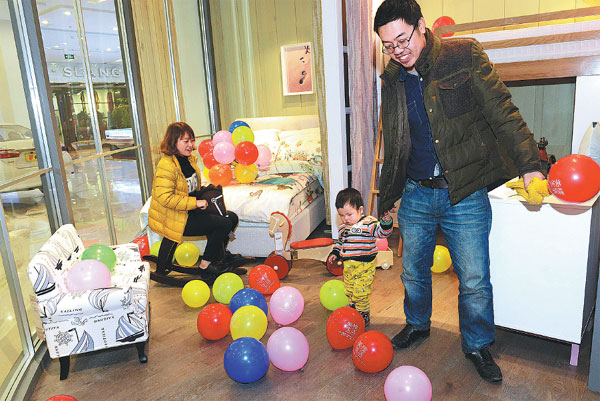Styles that sit well with the young people

New homeowners are moving away from traditional Chinese furniture and opting instead for a more European aesthetic
The preference of Chinese millennials for fine furniture has brought new opportunities for interior designers and premium furniture brands, especially those from Northern Europe.
As people born in the 1980s and 1990s acquire their first homes, the market has seen a marked shift in taste. It has gone from predominantly traditional Chinese aesthetics - featuring heavy wooden furniture and dark-red floors made of expensive, sometimes rare woods - to simpler Western styles.
Sugar Lee, a 29-year-old Shanghai-based home design magazine editor, spent about nine months decorating her home with her partner. It cost the young couple about 270,000 yuan ($41,190; 34,700 euros; £30,600) to do up their 46-square-meter home.
| A father plays with his child in a sample room of a furniture design company in Rizhao, Shandong province. Chen Weifeng / For China Daily |
Defining their home as a fusion of French and Northern European styles, most of their furniture was bought in design shops in Shanghai, like Design Republic, Casa Casa and BoConcept. Cheaper pieces from Ikea can also be found in their home.
"The younger generation has undoubtedly developed different tastes," Lee says. "We are more international, influenced by all kinds of ideas from around the world."
Neil Wang, president of consultancy Frost and Sullivan Greater China, says that the shift in taste is due to the different concepts and lives being pursued by younger Chinese people, compared with their parents.
"Simpler interior designs from Japan and Northern Europe are more budget-friendly. With the ever-climbing prices of houses, younger people don't have much money left for the luxury Chinese wooden furniture their elders preferred," Wang says.
He says their demographics mean they are always open to new experiences, which means changing their furniture more often.
"Many young people rent homes and are constantly on the move, so they want furniture that is more affordable and can be thrown away," Wang says.
"Also, their fast-paced work and lives place mental stress on the young, and this also helps explain why they want to live in places with light, simple and clean designs," Wang adds.
"It provides a sense of comfort, compared with heavy and serious Chinese furniture."
The latest trend in interior design has opened a door for international premium brands and for young designers.
In early September, the East Design Show was successfully held at the China International Furniture Fair in Shanghai. The show attracted foreign retailers and designers.
Swedish Wood, a unit of the Swedish Forest Industries Federation, which promotes the use of pine in sustainable designs, was represented at the event.
"The popularity of Northern European designs has encouraged the use of pine and timber product imports, designers and companies," says Swedish Wood representative Jiang Yincheng.
"But to fully meet the tastes of Chinese young people, the industry still needs to study the demographics more."
Jiang says he thinks younger Chinese consumers are more rational in their purchasing decisions, since they value design highly.
"Materials should not be the only criteria when deciding whether a piece of furniture is good or bad," Jiang says.
"Changing concepts about what makes a good piece of furniture have made creative design and various materials possible and profitable."
Many young and ambitious designers are on the same wavelength. Li Xiaoying, a 28-year-old interior design graduate based in Shanghai, says that although she currently works on hotel room designs, she would like to apply for a housing design job in a few years.
"There is a joke among designers," Li says. "When you walk into a well-furnished design studio, you may start to assess the wallpaper by the color density, the pattern, the brightness, the tone, the underlining essence and how well it goes with the rest of the room. But your parent may say: 'It's just a piece of paper, so why does it cost so much?'"
Li says that although it is still hard to force people to pay for the ideas and design work behind a product - and moves to prevent copyright violations are still taking time to become fully effective - younger people are slowly changing their mindsets and starting to appreciate intellectual property.
Consultant Wang says the preference for premium and designer furniture indicates that younger consumers understand and recognize the efforts and values put into design.
"The younger generation is more willing to pay, and pay more, for intellectual property."
He says designers, especially younger ones, have similar concepts and life pursuits to their peers in different lines of work, and they understand each other's needs better.
"They may not have decades of work experience, but they have the empathy to make up for it," he says.
"Such recognition is boosting demand for creative designers and companies, creating growth opportunities and promising career paths for them."
Alongside the success of foreign brands - mainstream retailers like Ikea and premium ones like BoConcept - the pursuit of quality of life and appreciation of design has fertilized many independent designer shops.
Hidden along the flourishing Guozijian Road, in the central hutong area of Beijing, are Fnji and Lost and Found. The two indie furniture shops are not short of admirers who appreciate their simple but quality furniture.
Having started out on Guozijian Road in 2008, Lost and Found focuses on vintage furniture and homeware and has a young design team whose average age is below 30.
"Our products are simple but classic. We cut out all the unnecessary decorative details and focus on how practical it should be," says Yuan Yue, public relations manager of Lost and Found.
"For example, we use solid wood for chairs because then they won't easily wear out. We want to remind people to respect the material and craftsmanship."
Industrial analysts don't think such companies, which stock such items as spoons that can cost hundreds of yuan and have a passion for design and craftsmanship that takes priority over revenue, will ever grow into large businesses. But they may well become icons for the design industry.
"Flagship design shops like Fnji and Lost and Found appeal to very specific demographics - to people who like high quality and unique designs, unlike retail chains," Wang says.
"The nature of such marketing means that they will not become the industry leaders, but for designers, they have a significant symbolic meaning."
Contact the writers at renxiaojin@chinadaily.com.cn

(China Daily European Weekly 10/06/2017 page27)
Today's Top News
- Expert debunks Lai's 'four elements' argument for Taiwan's so-called statehood
- China opposes any tariff deal made at its expense: commerce ministry
- Nepal's hydropower a climate change solution
- UN Charter still guiding compass of humankind
- Leaders pledge to strengthen Sino-Senegalese relations
- China, Ecuador to support each other's core interests































